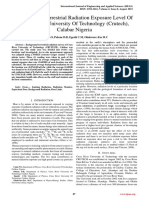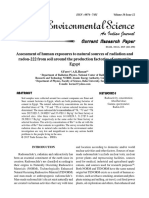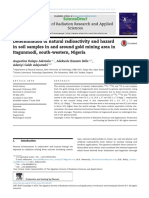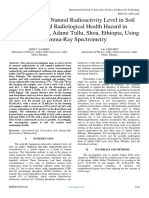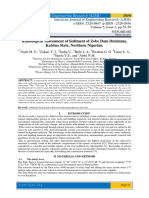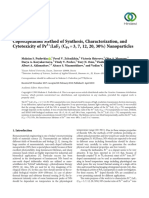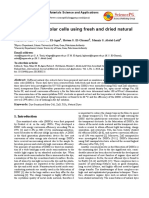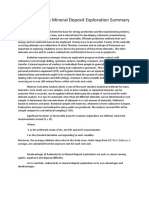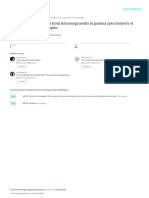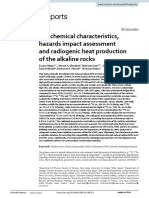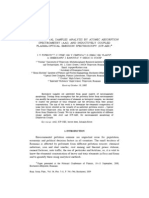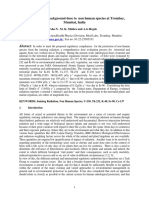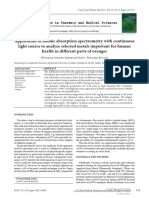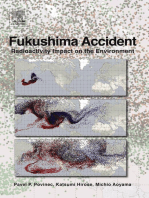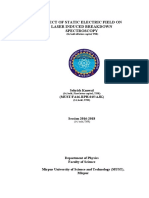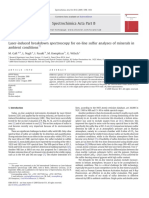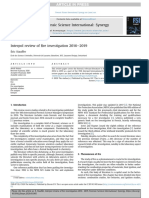Professional Documents
Culture Documents
Quantifying of Radioactive Elements in Soil, Water and Plant Samples Using Laser Induced Breakdown Spectroscopy (LIBS) Technique
Quantifying of Radioactive Elements in Soil, Water and Plant Samples Using Laser Induced Breakdown Spectroscopy (LIBS) Technique
Original Title
Copyright
Available Formats
Share this document
Did you find this document useful?
Is this content inappropriate?
Report this DocumentCopyright:
Available Formats
Quantifying of Radioactive Elements in Soil, Water and Plant Samples Using Laser Induced Breakdown Spectroscopy (LIBS) Technique
Quantifying of Radioactive Elements in Soil, Water and Plant Samples Using Laser Induced Breakdown Spectroscopy (LIBS) Technique
Copyright:
Available Formats
Volume 9, Issue 4, April – 2024 International Journal of Innovative Science and Research Technology
ISSN No:-2456-2165 https://doi.org/10.38124/ijisrt/IJISRT24APR105
Quantifying of Radioactive Elements in Soil,
Water and Plant Samples using Laser Induced
Breakdown Spectroscopy (LIBS) Technique
Faycal Ghourbal Abdoulaye1 Omar Bashir Adam Yousef2
1 2
Department of Physics-Faculty of Education- University of Department of Physics-Faculty of Education- University of
Nyala-Sudan & Department of Physics-Faculty of Science Nyala-Sudan
and Technology-ADM BARKA University-Abèché-Tchad
M.A. Abdalrasool3 A.S. Hamid4
4
3Department of Physics- College of Science- Sudan Renewable and Alternative Energy Researches Centre - Al
University of Science and Technology & Department of Neelain University, Khartoum- Sudan & Department of
Material Science- Faculty of Science & Technology, Al- Laser & Renewable Energy- Faculty of Science &
Neelain University, Khartoum- Sudan Technology- Al-Neelain University, Khartoum, -Sudan
Mohmed Ibrahim Mohamed Omer 5
5
Department of Physics-Faculty of Education, Nile Valley University -Sudan
Abstract:- In this study, the laser-induced breakdown effects in addition to radiation burns (similar to thermal burns)
spectroscopy (LIBS) technique was applied to detect These effects depending on the type of radiation, the exposure
radioactive elements on surface soil, plant leaves dose, the time exposure, and the sensitivity of the exposed
(Tamarindus indica), and flow water collected from Bala, tissues [4,5].
Mayo-Kebbi Quest, Chad. The survey process indicates
that the samples contain radioactive elements U, Fr, Ce, Laser-induced breakdown spectroscopy (LIBS) involves
Ac, Cm, Tb, and Pm. The concentrations of the detected the collection and processing of the spectral signature
elements in samples were determined using the resulting from a high-irradiance pulsed laser generated plasma
calibration curve method, while the plasma temperatures containing an analyte [6-8]. It is also regarded as a sensitive
(Texc) and electron density (Ne) of the detected radioactive technique that can detect most elements in the range of μg g-
elements were calculated from Boltzmann linear plots. 1[9]. The purpose of this study is to determine the radioactive
Except for uranium, all elements in the soil sample had elements contained in soil, water, and plant (Tamarindus
amounts below the acceptable limit. The concentration of indica) samples taken in Bala, Mayo-Kebbi Quest, Chad. The
uranium in soil samples ranges from 0.024236 to 0.23439 presence of these elements can have major biological
ppm, with a safety limit of 0.03 ppm. The average plasma consequences.
temperature Texc for uranium (U) is 700, while the
electron density Ne is 500 cm-3. II. METHOD
Keywords:- LIBS, Plasma, Radioactive, Tamarindus Indica, Samples collection: In present work, a total of three
Temperature and Electron Density. samples of soil, water, and plan leaves (Tamarindus indica)
have been collected from Bala, Mayo-Kebbi Quest, Chad (9o,
I. INTRODUCTION 21'48" N14o54'36" E). The sample of soil was taken from the
surface; the plant sample was Tamarindus indica leaves; and
Radioactive materials are substances that contain the water sample was running water. All samples were used
unstable nuclei that spontaneously emit radiation in the form without treatment.
of alpha particles, beta particles, or gamma rays in order to
stabilize themselves in process known as radioactive decay LIBS Setup: The analysis of (surface soil, Plant
[1,2]. These materials can be found naturally or artificially (Tamarindus indica) and water) samples was carried out using
produced in laboratories [3]. Exposure to radiation cause set up depicted schematically in Fig (1).
Acute Radiation Syndrome (ARS) (nausea, vomiting,
diarrhea, and weakness. Exposure to radiation cause Acute
Radiation Syndrome (ARS), it is increasing the risk of
developing cancer and genetic Effects (DNA mutations),
likewise it can lead to organ damage Also, it can cause
cardiovascular disease and cataracts as long-term health
IJISRT24APR105 www.ijisrt.com 1149
Volume 9, Issue 4, April – 2024 International Journal of Innovative Science and Research Technology
ISSN No:-2456-2165 https://doi.org/10.38124/ijisrt/IJISRT24APR105
(1)
Where νji is the frequency of the transition from state
j→i, Aij the Einstein coefficient for spontaneous emission, Nj
the population of the upper-level j and h is the Planks
constant [14-16]. The calibration curve for radioactive
elements in soil, water, and plant samples is illustrated in
figure (3), the concentration of detected elements ranged
from 200 ppm for A to 500 ppm for X, as shown in table 1.
According to the International Atomic Energy Agency
(IAEA) and the World Health Organization (WHO), the
results demonstrate that the concentration of all elements,
except uranium, on the soil sample is within the permissible
range. Uranium concentrations in soil samples ranged from
0.024236 to 0.23439 ppm, while in water and plant samples
they were 0.024705 ppm, with a safety limit of 0.03 ppm.
As uranium exceeded the permissible safety limits, it
Fig 1 Shows the Experimental Setup for LIBS Evaluation of was necessary to know the risk involved. Uranium can cause
Soil, Plants, and Water both radiological and chemical toxicity, and the quantity and
duration of exposure influence the health effects, with the
The LIBS system includes an Ocean Optics LIBS 2000+ kidneys and lungs being the main targets. Workers who have
spectrometer, a sample container, a diode laser, and OOILIBS been exposed to uranium have reported some impairment of
software. The 400 nm radiation released at fundamental kidney function. Inhaled insoluble uranium particles, 1–10
frequency from the diode laser was used to generate a plasma µm in size, can cause lung irradiation damage and cancer if
spark on the target surface. A convex lens (focal length 30 exposed to a high enough radiation dosage over time. Even
mm) was used for focus the laser beam onto sample. The after many weeks, direct dealing with the uranium in metallic
pulse energy used in these experiments was equal to 100 mJ. form is likely to result in radiation-induced erythema or other
The light from the plasma spark is captured via an optical short-term consequences [17,18].
cable equipped with a SMA connection. The USB 2000+ has
four spectrometer modules that give high resolution (FWHM Plasma temperatures Texc and electron density Ne of all
0.1 nm) and a gated CCD detector with 14,336 pixels for identified elements were determined using Boltzmann linear
simultaneous spectra recording in the 400 nm to 1150 nm plots based on Eq (1). The population density of upper-level
wavelength range. The emission is collected at a 45° angle Nj is related to ground-level number density (N) by
from the incoming laser energy. The data was then captured Boltzmann's equation [16].
and used to reconstruct the spectrum [10-13].
(2)
III. RESULTS & DISCUSSION
By Substate the Value of Nj we get:
After the Samples were Collected, the Experiment was
Carried Out, and the Results were Shown as Follows:
(3)
Figure (2) displays the spectrum of three samples (soil,
plant, and water). The recorded spectra were analyzed with
the aid of the NIST database. The spectra of three samples In the equation above, gj is the statistical weight, Ej is
showed several radioactive elements (U, Fr, Ce, Ac, Cm, Tb, the energy of upper- level j, Q is the partition function, K is
and Pm). Boltzmann's constant, and T is the plasma's electron
temperature.
The concentration of the identified elements was
calculated using the calibration curve method using the total
intensity of a spectral line (I) from an excited atom or ion in
plasma during a transition from state j→i. It is given by.
IJISRT24APR105 www.ijisrt.com 1150
Volume 9, Issue 4, April – 2024 International Journal of Innovative Science and Research Technology
ISSN No:-2456-2165 https://doi.org/10.38124/ijisrt/IJISRT24APR105
Fig 2 LIBS Spectrum of Soil, Water and Plant Samples Irradiated with100 mJ
Fig 3 Calibration Curve for Radioactive Elements Detected in Soil, Water and Plant Samples Obtained using
Analytic Calibration Function
IJISRT24APR105 www.ijisrt.com 1151
Volume 9, Issue 4, April – 2024 International Journal of Innovative Science and Research Technology
ISSN No:-2456-2165 https://doi.org/10.38124/ijisrt/IJISRT24APR105
Table 1 Analyzed Data of Libs Spectra Soil, Water and Plant Samples Irradiated by 400 Mj
The temperature and electron density were evaluated using the Boltzmann plot by plotting ln (I λ/g jAij) as a function of
energy (Ej/kB) [19,20], as displayed in figure (4).
Fig 4 Shows a Typical Linear Boltzmann Plot for Calculating Plasma Temperature for Radioactive Elements
Exist on Soil, Water, and Plant Samples
The Plasma Electronic Density can be Determined using the Following Relation:
(4)
Where T is the Plasma Temperature (K) and Eij is the transition energy (eV) [21,22].
IJISRT24APR105 www.ijisrt.com 1152
Volume 9, Issue 4, April – 2024 International Journal of Innovative Science and Research Technology
ISSN No:-2456-2165 https://doi.org/10.38124/ijisrt/IJISRT24APR105
Table 1 Plasma Temperature and Electron Density of Radioactive Elements Detected in Soil,
Water and Plant Samples Irradiated by 400 Mj
samples
Elements
Cm I UI Ce I Fr I Ac Tb Pm
4223
(1020cm-3) (Ko) (1020cm-3) (Ko) (1020cm-3) (Ko)
Texc
3310 3531 2313
3907
Soil
9.509
Ne
7.171 5.142 0.863
2.607
Texc
3920 4278 2476
Water
Ne
2.615 7.303 1.329
Texc
3920 3549 3477 2846
Plant
Ne
2.616 5.168 7.168 2.884
IV. CONCLUSIONS [6]. David A. Cremers, Sebastien Mauchien, and Milos,
Advances in Laser-Induced Breakdown Spectroscopy,
This paper presents an investigation of surface soil, plant Spectrochimica Acta Part B: Atomic Spectroscopy,
(Tamarindus indica), and flow water taken from Bala, Mayo- Elsever, Volume 166, April 2020, 105799,
Kebbi Quest, Chad, using LIBS technology. The study of the https://doi.org/10.1016/j.sab.2020.105799.
spectra with the aid of NIST revealed seven radioactive [7]. Jinto Thomas &Hem Chandra Joshi, Review on laser-
elements (Cm, U, Ce, Ac, Fr, Tb, and Pm); the concentrations induced breakdown spectroscopy: methodology and
of identified elements are within the allowed safety level technical developments, Applied Spectroscopy
except for uranium, but the cumulative impact must be Reviews Volume 59, 2024 -Issue1, Pages 124-155 |
considered to avoid biological consequences and mutations. Published online: 23 Mar 2023,
doi.org/10.1080/05704928. 2023.2187817
REFERENCES [8]. T Hussain1 and M A Gondal, Laser induced
breakdown spectroscopy (LIBS) as a rapid tool, for
[1]. Michael F. L’Annunziata, Radioactivity: Introduction material analysis, 6th Vacuum and Surface Sciences
and History from the quantum to quarks, 1st edition, Conference of Asia and Australia (VASSCAA-6),
Alsevier Science, June 24,2016. ISBN-13:978- Journal of Physics: Conference Series 439 (2013)
0444634894. 012050, IOP Publishing, doi:10.1088/1742-
[2]. John R. Lamarsh and Anthony J. Baratta, Introduction 6596/439/1/012050.
to Nuclear Engineering, 4th edition, Pearson, January [9]. Paulino R. Villas-Boas , Marco A. Franco, Ladislau
9,2017, ISBN-13:978-0134570057. Martin-Neto ,Hero T. Gollany and Debora M. B. P.
[3]. Glenn F. Knoll, Radiation Detection and Milori, Applications of laser-induced breakdown
Measurement, 4th edition, Wiley, August 16,2010, spectroscopy for soil analysis, part I: Review of
ISBN-13:978-0470131480. fundamentals and chemical and physical properties,
[4]. Michael F. L’Annunziata, Radioactivity History, European Journal of soil science, DOI:
Science, Vital Uses and Ominous Peril, 3rd edition, 10.1111/ejss.12888, 2019;1–16. ).
Alsevier Science, August 1,2022. ISBN-13:978- [10]. Hiba J. Alamin, A. M. Awadelgied, Kh M. Haroun,
0444634894 Abdalskhi.S.M., Spectroscopic Detection of Main
[5]. Thomas E. Johnson, Health Physics: Radiation- Elements (C, H, O, N and S) of Crude Oil Sample
Generating Devices, Characteristics, and Hazards, 1st from Melut Oilfield in Sudan Using Laser Induced
edition, Wiley-VCH, July 12,2016, ISBN-13:978- Breakdown Spectroscopy, International Journal of
3527411832 Innovative Science and Research Technology, Volume
4, Issue 4, April – 2019, ISSN No:-2456-2165.
IJISRT24APR105 www.ijisrt.com 1153
Volume 9, Issue 4, April – 2024 International Journal of Innovative Science and Research Technology
ISSN No:-2456-2165 https://doi.org/10.38124/ijisrt/IJISRT24APR105
[11]. Zeinab M.Mohammed, Kh M. Haroun, Mona Ali , [20]. Mahmoud Al-Salihi, Rongxing Yi, Shiqi Wang, Qiang
Abdalskhi S. M. H, Detection of Technetium on Soil, Wu, Fangrui Lin, Junle Qu, and Liwei Liu,
Plant and Water in the Area around Khartoum Quantitative laser-induced breakdown spectroscopy for
Petroleum Refinery by using Laser Induced discriminating neoplastic tissues from non-neoplastic
Breakdown Spectroscopy, International Journal of ones, Optics Express, Vol. 29, No. 3 / 1 February
Innovative Research in Sciences and Engineering 2021, https://doi.org/10.1364/OE.410878.
Studies (IJIRSES), ISSN: 2583-1658 | Volume: 2 [21]. Julian Stetzler, Shijun Tang and Rosemarie C. Chinni,
Issue: 7 | 2022. Plasma Temperature and Electron Density
[12]. Richard Viskup, Christoph Wolf and Werner Determination Using Laser-Induced Breakdown
Baumgartner, Laser Induced Breakdown Spectroscopy Spectroscopy (LIBS) in Earth’s and Mars’s
of Diesel Particulate Matter Exhaust Emissions Atmospheres, MDPI,Atoms 2020, 8, 50;
Generated from on Road Diesel Engine: Light Duty doi:10.3390/atoms8030050.
Vehicles, 7th International Conference on Photonics, [22]. A.H. Ahooeea, E. Hajiali, N. Amiri Rad, D. Shahabi,
Optics and Laser Technology (PHOTOPTICS 2019), Statistical Investigation of Electron Density of Laser-
pages 308-314, Science and Technology Publications, Air Interaction Sys-tem Using Saha Relation in Local
Lda., 2019. Thermodynamic Equilibrium, Transactions in
[13]. Nurul Absar, Jainal Abedin, Md. Mashiur Rahman, Theoretical and Mathematical Physics, TTMP vol 1(1),
Moazzem Hossain Miah, Naziba Siddique,Masud 2024 doi: 10.30511/TTMP.2023.709327.
Kamal, Mantazul Islam Chowdhury, Abdelmoneim
Adam Mohamed Sulieman , Mohammad Rashed Iqbal
Faruque , Mayeen Uddin Khandaker, David Andrew
Bradley and Abdullah Alsubaie, Radionuclides
Transfer from Soil to Tea Leaves and Estimation of
Committed Effective Dose to the Bangladesh
Populace, Life,MDPI 2021, 11,282.
https://doi.org/10.3390/life11040282.
[14]. Vinicius C. Costa, Diego V. Babos,b Jeyne P. Castro,
Daniel F. Andrade, Raimundo R. Gamela,b Raquel C.
Machado, Marco A. Sperança, Alisson S. Araújo, José
A. Garciab and Edenir R. Pereira-Filho, Calibration
Strategies Applied to Laser-Induced Breakdown
Spectroscopy: A Critical Review of Advances and
Challenges, J. Braz. Chem. Soc., Vol. 31, No. 12,
2439-2451, 2020, https://dx.doi.org/10.21577/0103-
5053.20200175.
[15]. Eleonora D’Andrea, Stefano Pagnotta, Emanuela
Grifoni, Stefano Legnaioli, Giulia Lorenzetti,
Vincenzo Palleschi, Beatrice Lazzerini, A Hybrid
Calibration-Free/Artificial Neural Networks Approach
to the Quantitative Analysis of LIBS Spectra, Applied
Physics B, Springer, laser and optics, volume 118,
pages353-360,01 January 2015, DOI:10.1007/s00340-
014-5990-z.
[16]. Ashwin P. Rao, Matthew T. Cook, Howard L. Hall,
and Michael B. Shattan, Quantitative Analysis of
Cerium-Gallium Alloys Using a Hand-Held Laser
Induced Breakdown Spectroscopy Device, Atoms
2019, 7, 84; doi:10.3390/atoms7030084,
[17]. Nuclear Safety Review 2023, IAEA/NSR/2023,
Printed in the IAEA in Austria August 2023.
[18]. National stockpiles for radiological and nuclear
emergencies: policy advice, ISBN 978-92-4-006787-5,
World Health Organization 2023.
[19]. Rosalba Gaudiuso , Marcella Dell’Aglio, Olga De
Pascale, Giorgio S. Senesi and Alessandro De
Giacomo, Laser Induced Breakdown Spectroscopy for
Elemental Analysis in Environmental, Cultural
Heritage and Space Applications: A Review of
Methods and Results, Sensors 2010, 10, 7434-7468;
doi:10.3390/s100807434.
IJISRT24APR105 www.ijisrt.com 1154
You might also like
- NDT-SA-ARAMCO-MCCL-PMI-57 Rev 00 Date 26-June-2023Document16 pagesNDT-SA-ARAMCO-MCCL-PMI-57 Rev 00 Date 26-June-2023SANJEEV YADAVNo ratings yet
- API RP 578 3rd Edition, Re-Written in New FormatDocument24 pagesAPI RP 578 3rd Edition, Re-Written in New FormatSooNo ratings yet
- IJEAS0208025Document3 pagesIJEAS0208025erpublicationNo ratings yet
- Assessment of Human Exposures To Natural PDFDocument10 pagesAssessment of Human Exposures To Natural PDFGhassan SaffariniNo ratings yet
- Environmental Radioactivity Assessment oDocument8 pagesEnvironmental Radioactivity Assessment oPataki SandorNo ratings yet
- Final PaperDocument9 pagesFinal PaperChun-Chih LinNo ratings yet
- Determination of Natural Radioactivity and Hazard in Soil Samples in and Around Gold Mining Area in Itagunmodi, South-Western, NigeriaDocument7 pagesDetermination of Natural Radioactivity and Hazard in Soil Samples in and Around Gold Mining Area in Itagunmodi, South-Western, NigeriawessilissaNo ratings yet
- Estimation of Radon Mass Exhalation Rate and Radium Content in Soil Samples Collected From Kolasib District of Mizoram, IndiaDocument8 pagesEstimation of Radon Mass Exhalation Rate and Radium Content in Soil Samples Collected From Kolasib District of Mizoram, IndiaIJRASETPublicationsNo ratings yet
- Articol RJP IvpopescuDocument8 pagesArticol RJP IvpopescuIuliana DumitrescuNo ratings yet
- JAAS - Rare Earth Elements and 143Nd-144Nd Isotope RatioDocument12 pagesJAAS - Rare Earth Elements and 143Nd-144Nd Isotope RatioamrewisNo ratings yet
- Assessment of Natural Radioactivity and Associated Radiation Hazards in Topsoil of Savar Industrial Area, Dhaka, BangladeshDocument9 pagesAssessment of Natural Radioactivity and Associated Radiation Hazards in Topsoil of Savar Industrial Area, Dhaka, BangladeshMd. Nazmul HossenNo ratings yet
- Radiological Information of Kelantan A RDocument5 pagesRadiological Information of Kelantan A RAfiq AmsyarNo ratings yet
- Radioactivity Assessment of K, U and TH in Surface Soil Samples of Igbokoda, Southwest of NigeriaDocument8 pagesRadioactivity Assessment of K, U and TH in Surface Soil Samples of Igbokoda, Southwest of Nigeriaemilie dodoNo ratings yet
- Exposure and Radon Exhalation Rate Building Material - 2014Document8 pagesExposure and Radon Exhalation Rate Building Material - 2014Rafael Angel LizaNo ratings yet
- Elemental Analysis of Itakpe Iron Ore by Energy DiDocument5 pagesElemental Analysis of Itakpe Iron Ore by Energy DiephremNo ratings yet
- Received September 14, 2009Document10 pagesReceived September 14, 2009Aftri Nur MaulidaNo ratings yet
- Evaluation of Radiological Impact of Some Nonnuclear Industries in North Suez Canal RegionDocument12 pagesEvaluation of Radiological Impact of Some Nonnuclear Industries in North Suez Canal RegionKhaled AllamNo ratings yet
- Ochradioecological Assesment of The Sediment of Kainji Lake Due To Natural RadionuclidesDocument5 pagesOchradioecological Assesment of The Sediment of Kainji Lake Due To Natural RadionuclidesOscar Montes LopezNo ratings yet
- Assessment of Environmental Impact of Some Industries in HelwanDocument17 pagesAssessment of Environmental Impact of Some Industries in HelwanKhaled AllamNo ratings yet
- Assessment of Natural Radioactivity Level in Soil Samples and Radiological Health Hazard in Floriculture Soil, Adami Tullu, Shoa, Ethiopia, Using Gamma-Ray SpectrometryDocument7 pagesAssessment of Natural Radioactivity Level in Soil Samples and Radiological Health Hazard in Floriculture Soil, Adami Tullu, Shoa, Ethiopia, Using Gamma-Ray SpectrometryInternational Journal of Innovative Science and Research TechnologyNo ratings yet
- 1 s2.0 S168785072200142X MainDocument12 pages1 s2.0 S168785072200142X MainAbdullah BasheerNo ratings yet
- Manuscript IDENTIFYING High Absorbed DoseDocument14 pagesManuscript IDENTIFYING High Absorbed DosewafaelyasNo ratings yet
- First Paper Shamsan PDFDocument3 pagesFirst Paper Shamsan PDFShamsan ObaidNo ratings yet
- Antibacterial - 1Document17 pagesAntibacterial - 1janviNo ratings yet
- Radiological Assessment of Sediment of Zobe Dam Dutsinma, Katsina State, Northern Nigerian.Document8 pagesRadiological Assessment of Sediment of Zobe Dam Dutsinma, Katsina State, Northern Nigerian.AJER JOURNALNo ratings yet
- Green Synthesis of Zinc Oxide Nanoparticles A ComparisonDocument7 pagesGreen Synthesis of Zinc Oxide Nanoparticles A ComparisonHazel Rene Gallegos MorenoNo ratings yet
- Application of Banana Peels Nanosorbent For The Removal of Radioactive Minerals From Real Mine WaterDocument8 pagesApplication of Banana Peels Nanosorbent For The Removal of Radioactive Minerals From Real Mine WaterNov Irmawati IndaNo ratings yet
- Green Synthesis of Zinc Oxide Nanoparticles A ComparisonDocument7 pagesGreen Synthesis of Zinc Oxide Nanoparticles A ComparisonSesha RajanNo ratings yet
- Numerical Investigation of Photonic Crystal Fiber-Based Biosensor For Pathogens Detection in WaterDocument9 pagesNumerical Investigation of Photonic Crystal Fiber-Based Biosensor For Pathogens Detection in WaterHemalatha RamamoorthyNo ratings yet
- Publication - Determination of The Activity Concentration of Some Premordial Radionuclides From Agricultural Soils Close To Artisanal Mining Sites of AtukuDocument14 pagesPublication - Determination of The Activity Concentration of Some Premordial Radionuclides From Agricultural Soils Close To Artisanal Mining Sites of AtukuSamson ArimatheaNo ratings yet
- Research ArticleDocument10 pagesResearch ArticleabcdNo ratings yet
- Radionuclides (Including Radon, Radium and Uranium) : Hazard SummaryDocument5 pagesRadionuclides (Including Radon, Radium and Uranium) : Hazard SummaryTahir KhattakNo ratings yet
- RamsarDocument7 pagesRamsaramirNo ratings yet
- The Areva Midwest Uranium Mining Project, Saskachewan, Canada. Public Health and Ethical Implications Chris Busby PHDDocument101 pagesThe Areva Midwest Uranium Mining Project, Saskachewan, Canada. Public Health and Ethical Implications Chris Busby PHDAkmens Raimonds - RAYSTAR100% (1)
- Preparation of GO Fe3O4@PMDA AuNPsDocument9 pagesPreparation of GO Fe3O4@PMDA AuNPsGilberto ZencovNo ratings yet
- Journal of Radioanalytical and Nuclear CDocument9 pagesJournal of Radioanalytical and Nuclear Cnauman18No ratings yet
- Atomic-Absorption Spectroscopy Methods For Analysis of Components From Contaminants and Biomedical ApplicationsDocument10 pagesAtomic-Absorption Spectroscopy Methods For Analysis of Components From Contaminants and Biomedical ApplicationsESTHER PEREZ TORRERONo ratings yet
- Investigation of Alpha and Beta Self-Absorption Factors in The Calibration of Water Sample MeasurementsDocument7 pagesInvestigation of Alpha and Beta Self-Absorption Factors in The Calibration of Water Sample MeasurementsLeons Rixson SiahaanNo ratings yet
- Dye-Sensitized Solar Cells Using Fresh and Dried Natural DyesDocument6 pagesDye-Sensitized Solar Cells Using Fresh and Dried Natural DyesAlessandra Resende GomesNo ratings yet
- Estimation of Radiation Dose Due To Air, Water and Sand Along South West Coast of Kanyakumari District, Tamil NaduDocument6 pagesEstimation of Radiation Dose Due To Air, Water and Sand Along South West Coast of Kanyakumari District, Tamil NaduInternational Journal of Innovative Science and Research TechnologyNo ratings yet
- Radioactivity in Mineral Deposit Exploration SummaryDocument1 pageRadioactivity in Mineral Deposit Exploration SummaryPrakkash RajantheranNo ratings yet
- Analysis of Interferences From Full Energy Peaks in Gamma Spectrometry of NORM and TENORM SamplesDocument9 pagesAnalysis of Interferences From Full Energy Peaks in Gamma Spectrometry of NORM and TENORM SamplesQueen MotaungNo ratings yet
- ARTICULO9Document10 pagesARTICULO9Yoselin GomezNo ratings yet
- Geochemical Characteristics, Hazards Impact Assessment and Radiogenic Heat Production of The Alkaline RocksDocument21 pagesGeochemical Characteristics, Hazards Impact Assessment and Radiogenic Heat Production of The Alkaline RocksNormanNo ratings yet
- Received October 10, 2008Document6 pagesReceived October 10, 2008trungkunmingNo ratings yet
- 5900 13949 1 SMDocument10 pages5900 13949 1 SMRussell FoxNo ratings yet
- Risk Assessment Through Ieubk Model in AnDocument8 pagesRisk Assessment Through Ieubk Model in Anaswar teknikNo ratings yet
- Evaluation of Background Dose To Non Human Species at Trombay, Mumbai, IndiaDocument10 pagesEvaluation of Background Dose To Non Human Species at Trombay, Mumbai, IndiaSabyasachi RoutNo ratings yet
- Radio NuclidesDocument12 pagesRadio NuclideswordssmithNo ratings yet
- Evaluation of Indoor Background Ionizing Radiation Profile in Some Hospitals in Jos, Plateau State-NigeriaDocument7 pagesEvaluation of Indoor Background Ionizing Radiation Profile in Some Hospitals in Jos, Plateau State-Nigeriadecker4449No ratings yet
- Microchemical Journal: SciencedirectDocument8 pagesMicrochemical Journal: SciencedirectErika Alejandra Pardo AcostaNo ratings yet
- Application of Atomic Absorption Spectrometry WithDocument3 pagesApplication of Atomic Absorption Spectrometry WithMunazza JabeenNo ratings yet
- 3 Goshu 3Document18 pages3 Goshu 3nega cheruNo ratings yet
- Zhan 2013Document8 pagesZhan 2013LizbethNo ratings yet
- Speciation of Antimony Using Dithizone Ligand Via Cloud Point Extraction and Determination by USN-ICP-OESDocument6 pagesSpeciation of Antimony Using Dithizone Ligand Via Cloud Point Extraction and Determination by USN-ICP-OESWi FuentesNo ratings yet
- Chang 2020 IOP Conf. Ser. - Earth Environ. Sci. 549 012025Document10 pagesChang 2020 IOP Conf. Ser. - Earth Environ. Sci. 549 012025oktrijayaNo ratings yet
- Elemental Analysis of Some Vegetables Cultivated in Delta Tuban, Lahej Governorate - YemenDocument12 pagesElemental Analysis of Some Vegetables Cultivated in Delta Tuban, Lahej Governorate - YemenInternational Journal of Innovative Science and Research TechnologyNo ratings yet
- ICP-OES and UV-VisDocument8 pagesICP-OES and UV-Vismahfuzur rahmanNo ratings yet
- Rapid Ident Depl Uranium Weapon Use Battlefield ConditionsDocument10 pagesRapid Ident Depl Uranium Weapon Use Battlefield ConditionsFadi IsaacNo ratings yet
- Normalizing XRF-scanner Data A Cautionary Note On The Interpretation of High-Resolution Records From Organic-Rich Lakes. Lowemark Et AlDocument7 pagesNormalizing XRF-scanner Data A Cautionary Note On The Interpretation of High-Resolution Records From Organic-Rich Lakes. Lowemark Et AlAlejandro Parra RojasNo ratings yet
- A Simple Rapid and Sensitive Method Based On Modified Multi 2019 Arabian JoDocument7 pagesA Simple Rapid and Sensitive Method Based On Modified Multi 2019 Arabian Jo95w8ngzjbmNo ratings yet
- Fukushima Accident: Radioactivity Impact on the EnvironmentFrom EverandFukushima Accident: Radioactivity Impact on the EnvironmentNo ratings yet
- Assessment of Integrated Poultry Manure and Synthetic Fertilizer Effects on Maize (Zea mays) Growth and Soil Properties: A Study from Bayero University, KanoDocument15 pagesAssessment of Integrated Poultry Manure and Synthetic Fertilizer Effects on Maize (Zea mays) Growth and Soil Properties: A Study from Bayero University, KanoInternational Journal of Innovative Science and Research Technology100% (1)
- Seasonal Variation and Distribution Patterns of Endophytic Community in Withania SomniferaDocument7 pagesSeasonal Variation and Distribution Patterns of Endophytic Community in Withania SomniferaInternational Journal of Innovative Science and Research TechnologyNo ratings yet
- Utilizing Chicken Eggshells and Waste Glass Powder as Cement Fillers for Environmental StabilityDocument6 pagesUtilizing Chicken Eggshells and Waste Glass Powder as Cement Fillers for Environmental StabilityInternational Journal of Innovative Science and Research TechnologyNo ratings yet
- Personal Capabilities of The Non-Teaching Personnel and Client SatisfactionDocument8 pagesPersonal Capabilities of The Non-Teaching Personnel and Client SatisfactionInternational Journal of Innovative Science and Research TechnologyNo ratings yet
- Transforming Challenges to Victories: An Inquiry on Transformational Leadership of School Leaders in the Public Elementary SchoolsDocument54 pagesTransforming Challenges to Victories: An Inquiry on Transformational Leadership of School Leaders in the Public Elementary SchoolsInternational Journal of Innovative Science and Research TechnologyNo ratings yet
- The Influence of Continuance Commitment on Job Satisfaction of Barangay Health Workers in Malaybalay City, BukidnonDocument14 pagesThe Influence of Continuance Commitment on Job Satisfaction of Barangay Health Workers in Malaybalay City, BukidnonInternational Journal of Innovative Science and Research TechnologyNo ratings yet
- Intelligent Clinical Documentation: Harnessing Generative AI For Patient-Centric Clinical Note GenerationDocument15 pagesIntelligent Clinical Documentation: Harnessing Generative AI For Patient-Centric Clinical Note GenerationInternational Journal of Innovative Science and Research TechnologyNo ratings yet
- Exploring The Potential Advantages of Traditional Therapies in Autoimmune Blistering Illnesses: A Comprehensive Review and Analysis, ResearchDocument12 pagesExploring The Potential Advantages of Traditional Therapies in Autoimmune Blistering Illnesses: A Comprehensive Review and Analysis, ResearchInternational Journal of Innovative Science and Research TechnologyNo ratings yet
- Meta Land: Redefining Virtual Communities Through Centralized Governance, Inclusivity and InnovationDocument5 pagesMeta Land: Redefining Virtual Communities Through Centralized Governance, Inclusivity and InnovationInternational Journal of Innovative Science and Research TechnologyNo ratings yet
- Solar Based Multilevel Inverter F o R BLDC Motor DriveDocument8 pagesSolar Based Multilevel Inverter F o R BLDC Motor DriveInternational Journal of Innovative Science and Research TechnologyNo ratings yet
- Skin Disease Detection and Remedial SystemDocument7 pagesSkin Disease Detection and Remedial SystemInternational Journal of Innovative Science and Research TechnologyNo ratings yet
- Design and Development of Multi-Featured Medical StretcherDocument4 pagesDesign and Development of Multi-Featured Medical StretcherInternational Journal of Innovative Science and Research TechnologyNo ratings yet
- EmoConnect: Nurturing Trust and Relationship Bonds in Alzheimer's ConversationsDocument3 pagesEmoConnect: Nurturing Trust and Relationship Bonds in Alzheimer's ConversationsInternational Journal of Innovative Science and Research TechnologyNo ratings yet
- Unlocking Sentiments: Enhancing IOCL Petrol Pump ExperiencesDocument8 pagesUnlocking Sentiments: Enhancing IOCL Petrol Pump ExperiencesInternational Journal of Innovative Science and Research TechnologyNo ratings yet
- Smart and Secure Home With ChatbotDocument9 pagesSmart and Secure Home With ChatbotInternational Journal of Innovative Science and Research TechnologyNo ratings yet
- Preparation and Identification of Magnetic Iron Nanoparticle Based On A Natural Hydrogel and Its Performance in Targeted Drug DeliveryDocument17 pagesPreparation and Identification of Magnetic Iron Nanoparticle Based On A Natural Hydrogel and Its Performance in Targeted Drug DeliveryInternational Journal of Innovative Science and Research TechnologyNo ratings yet
- Development of Smart Ground Fault Location Model For Radial Distribution SystemDocument14 pagesDevelopment of Smart Ground Fault Location Model For Radial Distribution SystemInternational Journal of Innovative Science and Research TechnologyNo ratings yet
- Fall Detection and Boundary Detection in Care HomesDocument7 pagesFall Detection and Boundary Detection in Care HomesInternational Journal of Innovative Science and Research TechnologyNo ratings yet
- Application of Plant Growth Promoting Rhizobacteria On Vegetative Growth in Chili Plants (Capsicum Frutescens L.)Document7 pagesApplication of Plant Growth Promoting Rhizobacteria On Vegetative Growth in Chili Plants (Capsicum Frutescens L.)International Journal of Innovative Science and Research TechnologyNo ratings yet
- Exploring The Post-Annealing Influence On Stannous Oxide Thin Films Via Chemical Bath Deposition Technique: Unveiling Structural, Optical, and Electrical DynamicsDocument7 pagesExploring The Post-Annealing Influence On Stannous Oxide Thin Films Via Chemical Bath Deposition Technique: Unveiling Structural, Optical, and Electrical DynamicsInternational Journal of Innovative Science and Research TechnologyNo ratings yet
- Reading Intervention Through "Brigada Sa Pagbasa": Viewpoint of Primary Grade TeachersDocument3 pagesReading Intervention Through "Brigada Sa Pagbasa": Viewpoint of Primary Grade TeachersInternational Journal of Innovative Science and Research TechnologyNo ratings yet
- Firm Size As A Mediator Between Inventory Management Andperformance of Nigerian CompaniesDocument8 pagesFirm Size As A Mediator Between Inventory Management Andperformance of Nigerian CompaniesInternational Journal of Innovative Science and Research TechnologyNo ratings yet
- Application of Game Theory in Solving Urban Water Challenges in Ibadan-North Local Government Area, Oyo State, NigeriaDocument9 pagesApplication of Game Theory in Solving Urban Water Challenges in Ibadan-North Local Government Area, Oyo State, NigeriaInternational Journal of Innovative Science and Research TechnologyNo ratings yet
- Global Warming Reduction Proposal AssessmentDocument6 pagesGlobal Warming Reduction Proposal AssessmentInternational Journal of Innovative Science and Research TechnologyNo ratings yet
- On The Development of A Threat Driven Model For Campus NetworkDocument14 pagesOn The Development of A Threat Driven Model For Campus NetworkInternational Journal of Innovative Science and Research TechnologyNo ratings yet
- Detection of Phishing WebsitesDocument6 pagesDetection of Phishing WebsitesInternational Journal of Innovative Science and Research TechnologyNo ratings yet
- A Study To Assess The Knowledge Regarding Teratogens Among The Husbands of Antenatal Mother Visiting Obstetrics and Gynecology OPD of Sharda Hospital, Greater Noida, UpDocument5 pagesA Study To Assess The Knowledge Regarding Teratogens Among The Husbands of Antenatal Mother Visiting Obstetrics and Gynecology OPD of Sharda Hospital, Greater Noida, UpInternational Journal of Innovative Science and Research TechnologyNo ratings yet
- PHREEQ C Modelling Tool Application To Determine The Effect of Anions On Speciation of Selected Metals in Water Systems Within Kajiado North Constituency in KenyaDocument71 pagesPHREEQ C Modelling Tool Application To Determine The Effect of Anions On Speciation of Selected Metals in Water Systems Within Kajiado North Constituency in KenyaInternational Journal of Innovative Science and Research TechnologyNo ratings yet
- Mandibular Mass Revealing Vesicular Thyroid Carcinoma A Case ReportDocument5 pagesMandibular Mass Revealing Vesicular Thyroid Carcinoma A Case ReportInternational Journal of Innovative Science and Research TechnologyNo ratings yet
- Esophageal Melanoma - A Rare NeoplasmDocument3 pagesEsophageal Melanoma - A Rare NeoplasmInternational Journal of Innovative Science and Research TechnologyNo ratings yet
- Spectrochimica Acta Part B: E. Tognoni, G. Cristoforetti, S. Legnaioli, V. PalleschiDocument14 pagesSpectrochimica Acta Part B: E. Tognoni, G. Cristoforetti, S. Legnaioli, V. PalleschibetjodaNo ratings yet
- Filter AS - 131264 - EA-300 - C - 626O51 - KIB - GB - 2013 - 3Document16 pagesFilter AS - 131264 - EA-300 - C - 626O51 - KIB - GB - 2013 - 3tham.lethihongNo ratings yet
- Novel Uses For Agilent ICP-MS in A Changing WorldDocument8 pagesNovel Uses For Agilent ICP-MS in A Changing WorldXANPHOXYL KIBETNo ratings yet
- BrassDocument8 pagesBrassameet kumarNo ratings yet
- Hitachi 10 Spark OES Elements Guide ENDocument18 pagesHitachi 10 Spark OES Elements Guide ENGabriela Boeira Dall AgnolNo ratings yet
- Quantitative Analysis of A Brass Alloy Using CF-LIBS and A Laser Ablation Time-Of-Flight Mass Spectrometer - Request PDFDocument6 pagesQuantitative Analysis of A Brass Alloy Using CF-LIBS and A Laser Ablation Time-Of-Flight Mass Spectrometer - Request PDFameet kumarNo ratings yet
- Detecting REE Rich Areas in Heterogeneous Drill Cores Fro - 2021 - Journal of GeDocument16 pagesDetecting REE Rich Areas in Heterogeneous Drill Cores Fro - 2021 - Journal of GeEnzo GonzalezNo ratings yet
- Analytical Instrumentation For Copper Pyrometallurgy: Challenges and OpportunitiesDocument6 pagesAnalytical Instrumentation For Copper Pyrometallurgy: Challenges and OpportunitiesAutomatizacion UdecNo ratings yet
- Laser Focused Carbon Analysis: Fast, Accurate, Portable LIBS AnalysisDocument2 pagesLaser Focused Carbon Analysis: Fast, Accurate, Portable LIBS AnalysisGhaithNo ratings yet
- ASRB - TS Templates ChecklistsDocument36 pagesASRB - TS Templates Checklistsusman javedNo ratings yet
- Aluminum Scrap ManagementDocument21 pagesAluminum Scrap ManagementTushar AggarwalNo ratings yet
- Spectrochimica Acta Part B: M. Gaft, L. Nagli, I. Fasaki, M. Kompitsas, G. WilschDocument7 pagesSpectrochimica Acta Part B: M. Gaft, L. Nagli, I. Fasaki, M. Kompitsas, G. WilschNoviAndheraPurbandiniNo ratings yet
- Interpol Review of Fire Investigation 2016-2019 E Stauffer Forensic Sci Intl Synergy 2020Document14 pagesInterpol Review of Fire Investigation 2016-2019 E Stauffer Forensic Sci Intl Synergy 2020Richard HaggerNo ratings yet
- North American Galvanizing Status and OpportunitiesDocument16 pagesNorth American Galvanizing Status and OpportunitiesFrank GoodwinNo ratings yet
- Rasayan Journal of ChemistryDocument7 pagesRasayan Journal of ChemistryAli KhumaeniNo ratings yet
- Experimental and Theoretical Studies of Laser-Induced Breakdown Spectroscopy Emission From Iron Oxide: Studies of Atmospheric EffectsDocument23 pagesExperimental and Theoretical Studies of Laser-Induced Breakdown Spectroscopy Emission From Iron Oxide: Studies of Atmospheric EffectsPutu IndraNo ratings yet
- Basic Laser PrinciplesDocument19 pagesBasic Laser PrinciplesLeonardusNo ratings yet
- Journal of Quantitative Spectroscopy & Radiative Transfer: C. Aragón, J.A. AguileraDocument16 pagesJournal of Quantitative Spectroscopy & Radiative Transfer: C. Aragón, J.A. AguileraLuís Carlos Leva BorduchiNo ratings yet
- CV 2012Document12 pagesCV 2012Dr-Walid FemtosecondNo ratings yet
- Minerals and RocksDocument14 pagesMinerals and RocksCésar LópezNo ratings yet
- Investigation of Laser-Induced PlasmaDocument5 pagesInvestigation of Laser-Induced PlasmaAleksandar VučićNo ratings yet
- Air-Coupled Ultrasonic Testing With Sonoair R&D: Edition 41 AUGUST 2020Document24 pagesAir-Coupled Ultrasonic Testing With Sonoair R&D: Edition 41 AUGUST 2020Ahmed LepdaNo ratings yet
- Z 200 Libs Analyser Laser Induced Breakdown Spectroscopy21 - 59 - 37Document2 pagesZ 200 Libs Analyser Laser Induced Breakdown Spectroscopy21 - 59 - 37BUTUCARU PETRICANo ratings yet
- Laser Focused Carbon Analysis: Fast, Accurate, Portable LIBS AnalysisDocument2 pagesLaser Focused Carbon Analysis: Fast, Accurate, Portable LIBS AnalysisAndrew ShortlesNo ratings yet
- Abstracts-Gura Humorului 2006Document47 pagesAbstracts-Gura Humorului 2006androso100% (2)
- Black SH e Ed Laser Ablation Effects and ApplicationsDocument289 pagesBlack SH e Ed Laser Ablation Effects and ApplicationsMaxim KomarNo ratings yet
- Elemental Analysis of Kohl Using Laser Ablation and Atomic Absorption Spectroscopy (AAS) TechniquesDocument8 pagesElemental Analysis of Kohl Using Laser Ablation and Atomic Absorption Spectroscopy (AAS) TechniquesRuan RongyiNo ratings yet
- Proceedings of The Third Balkan Symposium On Archaeometry 2012Document107 pagesProceedings of The Third Balkan Symposium On Archaeometry 2012Lucian RatoiuNo ratings yet


